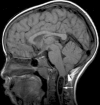Incidental findings on brain magnetic resonance imaging of children with sickle cell disease
- PMID: 20547639
- PMCID: PMC3153884
- DOI: 10.1542/peds.2009-2800
Incidental findings on brain magnetic resonance imaging of children with sickle cell disease
Abstract
Objective: We describe the prevalence and range of incidental intracranial abnormalities identified through MRI of the brain in a large group of children screened for a clinical trial.
Methods: We included 953 children between 5 and 14 years of age who were screened with MRI of the brain for the Silent Infarct Transfusion Trial. All had sickle cell anemia or sickle beta-null thalassemia. MRI scans were interpreted by 3 neuroradiologists. MRI scans reported to have any abnormality were reviewed by 2 study neuroradiologists. Incidental findings were classified into 4 categories, that is, no, routine, urgent, or immediate referral recommended. Cerebral infarctions and vascular lesions were not considered incidental and were excluded.
Results: We identified 63 children (6.6% [95% confidence interval: 5.1%-8.4%]) with 68 incidental intracranial MRI findings. Findings were classified as urgent in 6 cases (0.6%), routine in 25 cases (2.6%), and no referral required in 32 cases (3.4%). No children required immediate referral. Two children with urgent findings underwent surgery in the subsequent 6 months.
Conclusion: In this large cohort of children, incidental intracranial findings were identified for 6.6%, with potentially serious or urgent findings for 0.6%.
Figures







References
-
- Katzman GL, Dagher AP, Patronas NJ. Incidental findings on brain magnetic resonance imaging from 1000 asymptomatic volunteers. JAMA. 1999;282(1):36–39. - PubMed
-
- Weber F, Knopf H. Incidental findings in magnetic resonance imaging of the brains of healthy young men. J Neurol Sci. 2006;240(1-2):81–84. - PubMed
-
- Yue NC, Longstreth WT, Jr, Elster AD, Jungreis CA, O’Leary DH, Poirier VC. Clinically serious abnormalities found incidentally at MR imaging of the brain: Data from the cardiovascular health study. Radiology. 1997;202(1):41–46. - PubMed
-
- Vernooij MW, Ikram MA, Tanghe HL, et al. Incidental findings on brain MRI in the general population. N Engl J Med. 2007;357(18):1821–1828. - PubMed
Publication types
MeSH terms
Grants and funding
LinkOut - more resources
Full Text Sources
Medical

